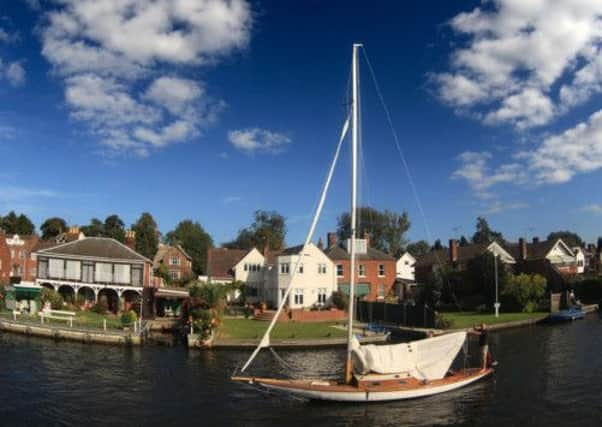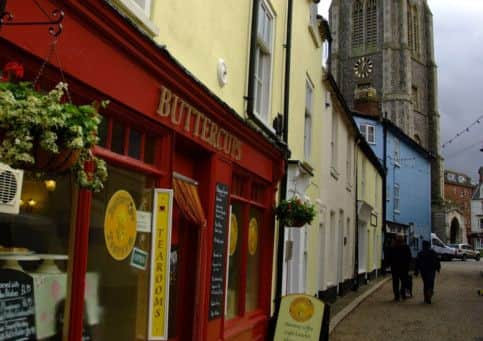Feast for the eyes


Tucking into freshly dressed crab in Cromer, it occurs to me that you could eat your way around north Norfolk.
From mussels in Morston and Stiffkey, shrimps in Sheringham and samphire – a kind of sea asparagus – found along the north Norfolk coast, to good old fish and chips or sticks of rock in the kiss-me-quick seaside resort of Great Yarmouth, no culinary stone is left unturned.
Advertisement
Hide AdAdvertisement
Hide AdBut to work up an appetite – and work off the calories – I’m well aware of the need for serious exercise on our travels. Thankfully, that isn’t difficult in Norfolk. Cycling routes abound, bracing coastal walks are an everywhere and you’re spoiled for choice with nature trails through acres of wildlife reserves.


Making our base in a Victorian cottage in Overstrand, about a mile-and-a-half from the seaside town of Cromer, famous for its crab, it’s great to be just far enough out of town to miss the crowds but able to zip in by bike or walk the vast stretch of sand and pebble beach which links the two spots.
Overstrand, a pretty village which houses a church, a pub and a post office-cum-village shop, also boasts a beautiful beach, but for more seaside adventures we take a bracing walk along this wild stretch of coastline where the vast sky meets the North Sea.
Here, seabirds sun themselves on the wooden posts stretching out into the water, locals walk their dogs and, in summer, holidaymakers flock to the brightly coloured huts fringing the beach at Cromer for fun in the sun.
Advertisement
Hide AdAdvertisement
Hide AdVenturing further, we put on our walking boots and head for the pristine salt marshes along Norfolk’s northern coast which are renowned for their beauty and abundant birdlife, past the Morston salt marshes, stopping for a bowl of steaming mussels at The Red Lion at Stiffkey.
No trip to Norfolk would be complete without a visit to the Broads. We drive to Wroxham, the capital of the Broads, where we hire a day cruiser equipped for up to eight passengers, complete with double hob, fridge, toilet, heater and, as we have gone for the luxury model, a radio. At a cost of about £90 a day in low season, it’s one to share between families if you can.
A day on the Broads is like stepping back in time. It reminds me of an Enid Blyton adventure – mugs of hot chocolate, a sense of adventure on the water as my son and daughter, Grace and William, try their hand at driving the boat and admiring the other crafts and luxury waterfront houses that we pass. There’s a surprise around every corner, whether it be a windmill, bridge or boat coming the other way.
As we meander up the Ant River, we pass windmills and busy mooring places until we find a spot where amateurs can park their crafts with relative ease, before venturing to a pub for lunch.
Advertisement
Hide AdAdvertisement
Hide AdBird-watching is big on the Broads, but this area is an ornithologist’s dream. Perched on the north Norfolk coast, the National Wildlife Trust’s Cley marshes is one of the UK’s finest bird-watching havens, its pools attracting waterbirds in their thousands.
We venture a little further north to Blakeney, where boat trips take visitors to view the seals at Blakeney Point. This is a world away from the amusement arcades and candy stores of resorts like Great Yarmouth, with just a couple of pubs, a fishmonger’s and a small grocery store.
Once we’ve had our fill of walks and wildlife, we venture back to Cromer, which grew up as a fishing village and became a popular holiday destination in the early 19th-century, with some of the rich Norwich banking families making it their summer home.
With its pier, built in 1902, Cromer still offers a traditional End of Pier show at the Pavilion theatre through the summer months and other shows out of season.
Advertisement
Hide AdAdvertisement
Hide AdIndeed, the pier is one of the main focal points, although much of the town’s history is evident if you venture further in. At Cromer Museum, we stand in a cosy fisherman’s cottage imagining what life might have been like 100 years ago. The museum has an impressive selection of fossils, along with remnants of the huge creatures which roamed the landscape before humans.
The town itself is a mixture of old and new – the museum is next to the church and a stone’s throw from the mix of trinket, bric-a-brac and expensive gift shops as well as sweet and chocolate emporiums such as Digbys, where you can buy everything from a quarter of liquorice coins to a handful of chocolate gravel.
But the beauty of Cromer really lies in its wide expanse of beach. On the glorious day that I walk the stretch from Overstrand, a man and his young son stand at the water’s edge throwing stones at a piece of driftwood being carried by the tide.
Absorbed by the game, the landscape and the setting, this amusement is light years away from the nearby arcades and the pier. So we put on our walking boots once more and set off along the beach front home – as the sun sets slowly in East Anglia.
Getting there
Advertisement
Hide AdAdvertisement
Hide AdHannah Stephenson stayed in Forsythia House, Overstrand, Norfolk, courtesy of Premier Cottages. A week’s stay in Poppyland Holiday Cottages for up to four people costs from £345 to £795. To book, visit www.premiercottages.co.uk or call 01263 577473.